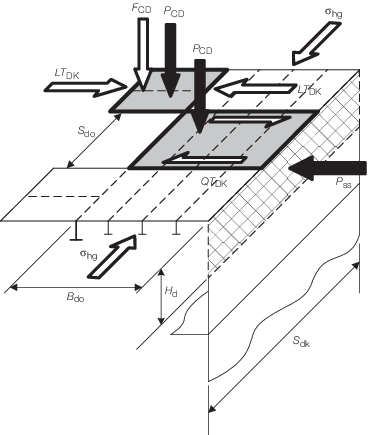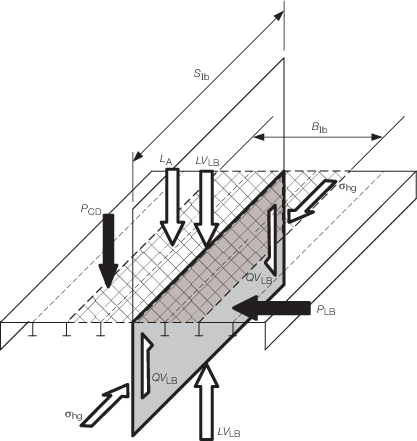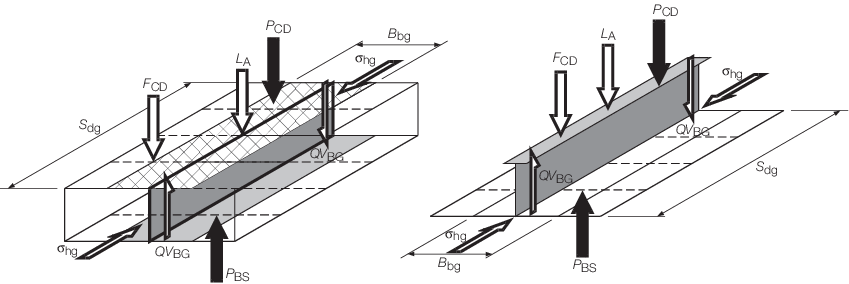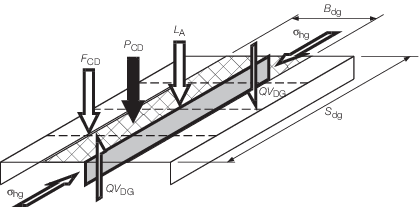
Section
4 Design load systems for longitudinally effective components

4.1 Bottom shell structures (BS)
4.1.2 The
design normal pressure, P
BS, for the bottom
shell plating and stiffeners is to be taken as:
where
4.1.3 The
design impulse pressure,  P
BS, for the bottom shell plating
and stiffeners is to be taken as
P
BS, for the bottom shell plating
and stiffeners is to be taken as
 P
bi
P
bi
|
= |
kN/m2 (bottom
impact)
|
where
4.1.5 The
design transverse load, LT
BS, due to hydrostatic
and hydrodynamic compressive loading is to be taken as follows:
|
LT
BS
|
= |
–εBS
P
SS
H
d
S
bs kN
|
where
|
H
d
|
= |
half the vertical distance from the keel to the first effective
full breadth deck above the inner bottom, or above the keel, in m.
If no effective full breadth decks exist, then H
d is
to be taken to the strength deck. H
d is illustrated
in Figure 2.4.2 Design parameter Hd for transverse
load
|
|
S
bs
|
= |
length of the bottom shell plating between major transverse
bulkheads, in metres |
|
εBS
|
= |
effectiveness
of the bottom shell plating, i.e. the relative proportion of the load
carried by the bottom shell as opposed to other structure such as
the inner bottom, floors and bulkheads |
| = |
0,5 for full breadth double bottom structures |
| = |
1,0 for single bottom structures or partial
breadth double bottom structures |
P
SS is to be taken at a height H
d/2 above the keel. P
SS is
defined in Vol 1, Pt 7, Ch 2, 3.6 External shell pressures 3.6.1
4.1.6 The
design global shear force, Q
D, may be ignored
for the bottom plating.

4.2 Side shell structures (SS)
4.2.3 The
design impulse pressure,  P
SS, for the side shell plating
and stiffeners is to be taken as follows:
P
SS, for the side shell plating
and stiffeners is to be taken as follows:
-
up to the design
waterline
 P
SS =
P
SS =  P
bi kN/m2 (bottom impact)
P
bi kN/m2 (bottom impact)
-
above the design
waterline
 P
SS =
P
SS =  P
bf kN/m2 (bow flare
impact)
P
bf kN/m2 (bow flare
impact)
where
 P
bi and
P
bi and  P
bf are defined in Vol 1, Pt 7, Ch 2, 2.1 Nomenclature 2.1.2
P
bf are defined in Vol 1, Pt 7, Ch 2, 2.1 Nomenclature 2.1.2
4.2.5 The
design vertical load, LV
SS, supported by the
side shell plating and stiffeners is to be taken as:
|
LV
SS
|
= |
–εSS (S
ss
B
ss
P
CD + L
A +
[F
CD] ) kN
|
where
|
εSS
|
= |
effectiveness
of the side shell plating, i.e. the relative proportion of the load
carried by the side shell as opposed to the bounding major transverse
bulkheads |
| = |
0,5 |
|
L
A
|
= |
appropriate load, in kN, from pillar(s), bulkheads and side
shell structure above the supported deck, assumed zero if there is
none over. L
A may be taken as LV
BP for the supported bulkhead. LV
PB is
given in Vol 1, Pt 7, Ch 2, 5.8 Pillar bulkheads (PB)
|
|
B
ss
|
= |
mean breadth of the supported deck plating, i.e. half the transverse
distance from the side shell to longitudinal bulkheads, or effectively
supported longitudinal girders, in metres |
|
S
ss
|
= |
length of the side shell between major transverse bulkheads,
in metres. |

4.3 Strength deck and internal deck structures (DK)
4.3.1 The
design normal pressure, P
DK, for the deck
plating and stiffeners is to be taken as the greater of the following,
provided that the load component is applicable:
-
P
WD (weather
deck pressure), see
Vol 1, Pt 7, Ch 2, 3.6 External shell pressures 3.6.2
-
 (interior deck pressure), see
Vol 1, Pt 7, Ch 2, 5.1 Deck structures (DK) 5.1.3 (interior deck pressure), see
Vol 1, Pt 7, Ch 2, 5.1 Deck structures (DK) 5.1.3
-
P
CD (cargo
deck pressure), see
Vol 1, Pt 7, Ch 2, 5.1 Deck structures (DK) 5.1.2
-
P
tk (deep
tank boundary, where appropriate).
4.3.3 The
design load matrix, [F
DK], in kN for the deck
plating and stiffeners is to be taken as the combination of the following,
as appropriate:
These loads are to be applied in addition to the
design pressures above.
4.3.4 Normally,
the design impulse pressure,  P
DK, for the deck plating and stiffeners
may be ignored. However, the design impulse pressure will need to
be considered for decks designed to withstand helicopter or aircraft
landing operations, cargo handling at sea or similar.
P
DK, for the deck plating and stiffeners
may be ignored. However, the design impulse pressure will need to
be considered for decks designed to withstand helicopter or aircraft
landing operations, cargo handling at sea or similar.
4.3.6 The
design transverse load, LT
DK, due to hydrostatic
and hydrodynamic compressive loading is to be taken as follows, see
also
Vol 1, Pt 7, Ch 2, 4.3 Strength deck and internal deck structures (DK) 4.3.8:
|
LT
DK
|
= |
–εDK
P
SS
H
d
S
dk kN
|
where
|
H
d
|
= |
half the vertical distance from the first full breadth deck
below the deck under consideration to the first full breadth deck
above this deck, or to the strength deck if there are no decks above,
in metres |
|
εDK
|
= |
effectiveness
of the deck, i.e. the relative proportion of the load carried by the
deck as opposed to other structure such as bulkheads |
| = |
0,8 |
P
SS is to be taken at the
mid height of the H
d depth, P
SS is defined in Vol 1, Pt 7, Ch 2, 3.6 External shell pressures 3.6.1
H
d is illustrated in Figure 2.4.2 Design parameter Hd for transverse
load

Figure 2.4.4 Design loads for the deck structure
4.3.8 If the
deck is not continuous across the full breadth, due to the presence
of large openings, then LT
DK may be taken
as zero over the opening breadth. In this case it may be necessary
to consider the local shear force in the deck plating due to hydrostatic
and hydrodynamic loading on the longitudinal span of the deck. This
shear force acts in the transverse direction and is to be taken as:
|
QT
DK
|
= |
P
SS
H
d
S
do/2 kN
|
where
|
S
do
|
= |
length of the deck plating between major transverse bulkheads
or the length of the deck opening, whichever is lesser, in metres |
P
SS and H
d are
defined in Vol 1, Pt 7, Ch 2, 4.3 Strength deck and internal deck structures (DK) 4.3.6
The
shear area of the deck plate supporting this shear load is to be based
on the breadth of the deck edge strip, B
do.

4.4 Inner bottom structures (IB)
4.4.1 For
all loading conditions, the design normal pressure,  , for the inner bottom plating and stiffeners is to be
taken as the greater of: , for the inner bottom plating and stiffeners is to be
taken as the greater of:
-
 (interior deck pressure), see
Vol 1, Pt 7, Ch 2, 5.1 Deck structures (DK) 5.1.3 (interior deck pressure), see
Vol 1, Pt 7, Ch 2, 5.1 Deck structures (DK) 5.1.3
-
P
CD (cargo
deck pressure), see
Vol 1, Pt 7, Ch 2, 5.1 Deck structures (DK) 5.1.2
-
P
tk (deep
tank pressure, where appropriate).
4.4.2 For
loading conditions which represent damaged situations, the design
normal pressure, , for the inner bottom plating and stiffeners is to be
taken as the greater of the following. If this is greater than Vol 1, Pt 7, Ch 2, 4.4 Inner bottom structures (IB) 4.4.1: , for the inner bottom plating and stiffeners is to be
taken as the greater of the following. If this is greater than Vol 1, Pt 7, Ch 2, 4.4 Inner bottom structures (IB) 4.4.1:
-
P
da (damage
head).
-
P
SS (pressure
on shell plating, where appropriate).
4.4.4 The
design impulse pressure for the inner bottom plating and stiffeners
may be ignored.
4.4.6 The
design transverse load,  , due to hydrostatic and hydrodynamic compressive loading
is to be taken as follows: , due to hydrostatic and hydrodynamic compressive loading
is to be taken as follows:

|
= |
–ε P
SS
H
d
S
ib kN
P
SS
H
d
S
ib kN
|
where
|
H
d
|
= |
half the vertical distance from the keel to the first full breadth
deck above the inner bottom, in metres |
ε
|
= |
effectiveness of the inner
bottom, i.e. the relative proportion of the load carried by the inner
bottom as opposed to other structure such as the bottom shell, floors
and bulkheads |
| = |
0,5 normally |
P
SS is to be taken at a height
of H
d/2 above the keel, P
SS is defined in Vol 1, Pt 7, Ch 2, 3.6 External shell pressures
H
d is illustrated in Figure 2.4.2 Design parameter Hd for transverse
load
4.4.7 The
design global shear force, Q
D, may be ignored
for the inner bottom plating.

4.5 Longitudinal bulkhead structures (LB)
4.5.2 The
design normal pressure for longitudinal bulkhead plating with vertical
stiffeners is to be considered separately for the plating and the
vertical stiffeners. The design normal pressure for the plating, P
LB, is to be taken as P
BHP as given
in Vol 1, Pt 7, Ch 2, 5.2 Transverse watertight and deep tank bulkheads (BH) 5.2.1. The design normal
pressure for the stiffener, P
LBS, is to be
taken as P
BHS as given in Vol 1, Pt 7, Ch 2, 5.2 Transverse watertight and deep tank bulkheads (BH) 5.2.1
4.5.3 The
design impulse pressure,  P
LB, for the longitudinal bulkhead
plating and stiffeners may be ignored, unless these members are likely
to be subjected to significant sloshing loads or similar.
P
LB, for the longitudinal bulkhead
plating and stiffeners may be ignored, unless these members are likely
to be subjected to significant sloshing loads or similar.
4.5.7 If the
longitudinal bulkhead is not continuous over the full depth of the
ship then it will be necessary to consider the local shear force in
the longitudinal bulkhead plating as the vertical load must be transferred
into the supporting structure, such as transverse bulkheads. This
shear force acts in the vertical direction and is to be taken as:
The shear area of the longitudinal bulkhead plate
supporting this shear load is to be based on the depth of the longitudinal
bulkhead between decks.

4.6 Bottom longitudinal girders (BG)
4.6.2 The
design normal pressure, P
BG, for girder web
plating is to be taken as the greater of:
-
P
tk kN/m2 (Deep Tank, if applicable), see
Vol 1, Pt 7, Ch 2, 5.1 Deck structures (DK) 5.1.4
-
P
da kN/m2 (WT subdivision, only if applicable and for loading
conditions which represent damaged situations), see
Vol 1, Pt 7, Ch 2, 5.1 Deck structures (DK) 5.1.4
-
5,0 (minimum value
for no direct loading).
4.6.3 The
design impulse pressure,  P
BG, for the bottom girder web
plating may be ignored, unless these members are subjected to sloshing
loads or similar.
P
BG, for the bottom girder web
plating may be ignored, unless these members are subjected to sloshing
loads or similar.
4.6.5 The
design vertical load, LV
BG, acting on the
web plating of bottom girders is to be based on the supported loads.
Typically these include downwards local inertial pressures, P
CD, inertial forces, [F
CD], and pillar
bulkhead loads above, L
A, all acting on the
plating of the inner bottom or the bottom girder flange and the upwards
buoyancy loads on the bottom shell plating, P
BS.
The design vertical load is to be taken as:
|
LV
BG
|
= |
–εBG (B
bg
S
bg (P
CD – P
BS )
+ [F
CD] + L
A) kN
|
where
|
ε
BG
|
= |
effectiveness of the bottom girders, i.e. the relative proportion
of the load carried by the bottom girders as opposed to other structure
such as the transverse floors |
| = |
0,5 |
|
B
bg
|
= |
mean spacing of longitudinal girders or other primary longitudinal
structure, in metres, see Note 2
|
|
S
bg
|
= |
span or length of the longitudinal girder between transverse
bulkheads, in metres |
P
BS is defined in Vol 1, Pt 7, Ch 2, 4.1 Bottom shell structures (BS) 4.1.2
P
CD is defined in Vol 1, Pt 7, Ch 2, 5.1 Deck structures (DK) 5.1.2
Note
1. For single bottom girders P
CD is
likely to be zero. In this situation B
bg =
span or length of the longitudinal girder between transverse bulkheads. P
CD should be taken as the distributed machinery
load, if it is not included in [F
CD].
Note
2. Where the girder is part of a longitudinally
stiffened bottom structure with closely spaced floors, the mean spacing B
bg may be taken as the spacing of the longitudinal
stiffeners. For grillage or transversely stiffened systems then the
spacing is to be taken as stated.

Figure 2.4.6 Loads to be applied to longitudinal bulkhead plating

Figure 2.4.7 Loads to be applied to bottom girders
4.6.6 The
design shear force for the bottom girder web plating is to include
local and global components.
-
The design global
shear force is to be taken as Q
D, as defined
in Vol 1, Pt 7, Ch 2, 3.3 Design global loads – Intact conditions or Vol 1, Pt 7, Ch 2, 3.4 Design global loads – Damaged conditions or Residual Strength Assessment (RSA) conditions. If the girder depth is reasonably
small then Q
D may be ignored.
-
The local shear
force component, QVBG, is due to the difference
between the buoyancy and the inertial forces. It acts in the vertical
direction and is to be taken as:
|
QVBG
|
= |
εBG (B
bg
S
bg (P
CD – P
BS) + [F
CD] + L A)/2 |
where
|
B
bg
|
= |
mean spacing of longitudinal girders or other primary longitudinal
structure, in metres, see Note 2.
|
4.6.7 The
design bending load for bottom girder primary member is to be taken
as:
εBG (B
bg
S
bg (P
CD – P
BS )
+ [F
CD] + L
A) kN

4.7 Deck girders (DG)
4.7.1 The
design normal pressure, P
DG, for deck girder
web plating may be ignored.
4.7.2 The
design impulse pressure,  P
DG, for deck girder web plating
may be ignored, unless these members are subjected to sloshing loads
or similar.
P
DG, for deck girder web plating
may be ignored, unless these members are subjected to sloshing loads
or similar.
4.7.4 The
design vertical load for deck girder webs may be ignored.
4.7.5 The
design shear force for the deck girder web plating is to include local
and global components.
-
The design global
shear force is to be taken as Q
D, as defined
in Vol 1, Pt 7, Ch 2, 3.3 Design global loads – Intact conditions or Vol 1, Pt 7, Ch 2, 3.4 Design global loads – Damaged conditions or Residual Strength Assessment (RSA) conditions. If the girder depth is reasonably
small then Q
D may be ignored.
-
The local shear
force component, QVDG, is due to the difference
between the buoyancy and the inertial forces. It acts in the vertical
direction and is to be taken as:
|
QV
DG
|
= |
εBG (B
dg
S
dg
P
CD + [F
CD]
+ L
A)/2 kN
|
where
|
εBG
|
= |
effectiveness
of the deck girders, i.e. the relative proportion of the load carried
by the deck girders as opposed to other structure such as the deck
beams |
| = |
0,5 |
|
S
dg
|
= |
span or length of the longitudinal girder between transverse
bulkheads, in metres |
|
L
A
|
= |
load, in kN, from pillar(s) above, assumed zero if there is
none over |

Figure 2.4.8 Loads to be applied to deck girders
4.7.7 The
design bending load for the deck girder primary member is to be taken
as:
εBG (B
dg
S
dg
P
CD + [F
CD]
+ L
A) kN.

4.8 Longitudinal stringers (ST)
4.8.1 This
sub-Section covers stringers supporting side shell plating, horizontal
girders on longitudinal bulkheads and also covers horizontal diaphragms
fitted between a double skin. The design loads are illustrated in Figure 2.4.9 Design loads for longitudinal stringers
4.8.2 The
design normal pressure, P
ST, for the web plating
of stringer may be ignored unless the stringer forms part of a tank
boundary or watertight subdivision, i.e. a watertight horizontal diaphragm.
In this case the design pressure is to be taken as the greater of
-
P
tk kN/m2 (Deep Tank, if applicable), see
Vol 1, Pt 7, Ch 2, 5.1 Deck structures (DK) 5.1.4
-
P
da kN/m2 (WT subdivision, only if applicable and for loading conditions
which represent damaged situations), see
Vol 1, Pt 7, Ch 2, 5.1 Deck structures (DK) 5.1.4.
-
5,0 (minimum value
for no direct loading).
4.8.3 The
design impulse pressure,  P
ST, for the web plating of stringer
may be ignored, unless these members are subjected to sloshing loads
or similar.
P
ST, for the web plating of stringer
may be ignored, unless these members are subjected to sloshing loads
or similar.
4.8.5 The
design transverse load, LT
ST, acting on the
web plating of horizontal diaphragms is to be based on the pressure
loads acting on the plating of the inner skin or longitudinal bulkhead P
LB (outwards) and the side shell P
SS (inwards). The design transverse load, LT
ST,
is to be taken as the lesser of:
-
–εST
B
st
S
st
P
SS kN
-
–εST
B
st
S
st
P
LB kN
where
|
εST
|
= |
effectiveness
of the horizontal diaphragms, i.e. the relative proportion of the
load carried by the horizontal diaphragms as opposed to other structure
such as the transverse web or normal frames |
| = |
0,5 |
|
H
st
|
= |
mean spacing, in metres, of stringers (or horizontal girders)
and other primary horizontal structure, i.e. decks or similar |
P
SS is to be taken as the
side shell pressure at the height of the stringer, see
Vol 1, Pt 7, Ch 2, 3.6 External shell pressures 3.6.1. P
SS is
to be ignored for horizontal girders attached to longitudinal bulkheads.
P
LB is to be taken as the longitudinal
bulkhead normal pressure at the height of the horizontal girder, see
Vol 1, Pt 7, Ch 2, 4.5 Longitudinal bulkhead structures (LB) 4.5.1 This is only
required for longitudinal bulkheads that form part of a deep tank
or watertight boundary.
Note Where the horizontal diaphragm is part of a longitudinally
stiffened structure with regular transverse webs, the mean spacing H
st may be based on the longitudinal spacing. For
grillage or transversely stiffened systems then the spacing is to
be taken as originally stated.
4.8.6 The
design transverse load, LT
ST, for stringers
and horizontal girders may be ignored.
4.8.7 The
design shear force, QT
ST, in the stringer
web due to hydrostatic, hydrodynamic or tank loading acts in the transverse
direction is to be taken as the greater of:
-
εST
H
st
S
st
P
SS/2
-
εST
H
st
S
st
P
LB/2
where
|
H
st
|
= |
mean spacing, in metres, of stringers (or horizontal girders)
and other primary horizontal structure, i.e. decks or similar. |
4.8.8 The
design bending load for the deck girder primary member is to be taken
as:
-
εST
H
st
S
st (P
SS – P
LB)
where
|
H
st
|
= |
mean spacing, in metres, of stringers (or horizontal girders)
and other primary horizontal structure, i.e. decks or similar. |
|